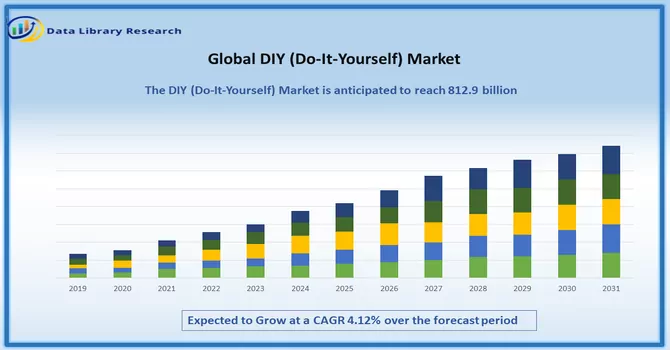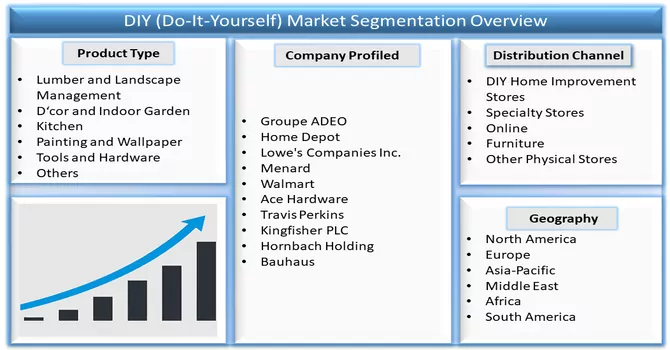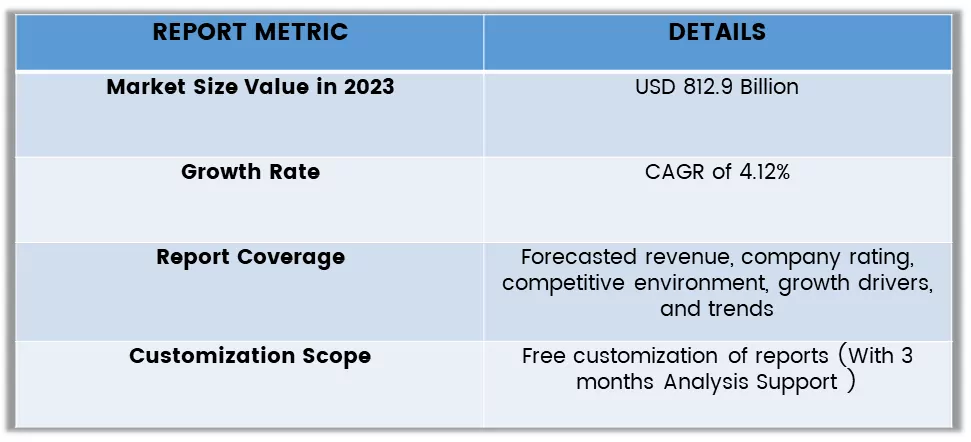The DIY Home Improvement Market size is estimated at USD 812.9 billion in 2023 and is expected to reach a CAGR of 4.12% over the forecast period, 2023-2031.

Get Complete Analysis Of The Report - Download Free Sample PDF
The DIY (Do-It-Yourself) market is a dynamic sector that caters to individuals seeking to undertake various home improvement, crafting, and repair projects independently. This market encompasses a wide range of products, including tools, building materials, paint, home decor, and gardening supplies, providing consumers with the resources to tackle projects on their own. The growing popularity of DIY culture, driven by factors such as the desire for cost savings, creative expression, and the convenience of self-driven endeavours, has contributed to the expansion and vitality of the DIY market.
Additionally, the increasing availability of online tutorials and a wealth of DIY-friendly products further fuel the growth of this market, making it a diverse and thriving industry.The growth of the DIY market is propelled by several key factors. Firstly, the increasing trend of consumers engaging in DIY activities is driven by the desire for cost savings and the satisfaction of completing projects independently. The availability of a wide range of user-friendly and innovative DIY products, coupled with the convenience of online tutorials and guides, further encourages individuals to take on various home improvement and crafting endeavors. Additionally, the DIY market benefits from the growing emphasis on sustainability, as many DIY projects focus on repurposing and upcycling, aligning with eco-friendly practices. The combination of these factors contributes to the robust expansion of the DIY market, catering to a diverse range of consumers seeking self-driven solutions for their projects.
Market Segmentation: Global DIY Home Improvement Market Analysis & Share and is Segmented By Product Type (Lumber and Landscape Management, D cor and Indoor Garden, Kitchen, Painting and Wallpaper, Tools and Hardware, Building Materials, Lighting, Plumbing and Equipment, Flooring, Repair and Replacement, and Electrical Work), By Distribution Channel (DIY Home Improvement Stores, Specialty Stores, Online, Furniture, and Other Physical Stores), and By Geography (North America, South America, Europe, Asia-Pacific, and Middle-East and Africa). The report offers market size and forecasts for the Global DIY Home Improvement Market in value (USD billion) for all the above segments.

For Detailed Market Segmentation - Download Free Sample PDF
The DIY market is witnessing notable trends shaped by evolving consumer preferences and industry innovations. One prominent trend is the increasing integration of technology into DIY activities, with the emergence of smart tools, mobile apps, and online platforms providing step-by-step guides and project assistance. The rise of sustainable and eco-friendly practices is another significant trend, driving the popularity of DIY projects centered around repurposing materials and promoting a circular economy. Moreover, the market is experiencing a surge in demand for DIY kits and subscription services, offering curated materials and instructions for specific projects. The DIY market is also influenced by a growing focus on customization, enabling consumers to create unique, personalized items for their homes. These trends collectively reflect the dynamic and diverse nature of the DIY market, catering to the evolving needs and preferences of DIY enthusiasts.
Market Drivers:
Rising homeownership rates
The surge in homeownership rates has become a prominent trend, shaped by evolving societal dynamics and economic factors. In recent years, there has been a notable increase in individuals aspiring to own their homes, driven by the desire for stability, independence, and a sense of accomplishment. As people pursue homeownership, the real estate market experiences a corresponding uptick, creating a ripple effect across related industries. Rising homeownership rates signify a growing market for home-related products and services, including home improvement, décor, and maintenance, as individuals take pride in personalizing and enhancing their living spaces. This trend has particularly fueled the demand for DIY solutions, as homeowners increasingly seek hands-on involvement in shaping and maintaining their residences.
Economic factors and budget constraints
Economic factors and budget constraints play a pivotal role in shaping consumer behavior and market dynamics. In times of economic fluctuations, individuals and businesses often face financial challenges, leading to a more cautious approach in spending. Tightened budgets and economic uncertainties can result in a shift towards cost-effective choices and value-driven purchasing decisions. As consumers prioritize essential needs over discretionary spending, industries may witness fluctuations in demand for certain products and services. Additionally, businesses may need to adapt by offering budget-friendly options or innovative solutions that align with the evolving economic landscape. The interplay between economic factors and budget constraints creates a dynamic environment that necessitates strategic planning and flexibility across various sectors.
Market Restraints:
Market restraints for the DIY market can be influenced by several factors. One significant constraint is the complexity and technical difficulty of certain do-it-yourself projects. As consumers engage in more sophisticated tasks, they may encounter challenges that require specialized skills or tools, limiting the widespread adoption of DIY activities. Additionally, economic downturns can act as a restraint, as consumers may reduce discretionary spending on non-essential home improvement projects. Availability and affordability of raw materials and tools, regulatory constraints, and safety concerns are other factors that can impede the growth of the DIY market. Overcoming these challenges often requires industry players to provide educational resources, user-friendly tools, and cost-effective solutions to empower consumers and enhance the overall DIY experience.
The COVID-19 pandemic has significantly impacted the DIY market, causing both challenges and opportunities. With lockdowns and social distancing measures in place, there was a surge in demand for DIY products and home improvement projects as individuals spent more time at home. Consumers, seeking to enhance their living spaces, turned to DIY activities for renovation, decoration, and organization. However, the DIY market also faced disruptions in the supply chain due to lockdowns and restrictions, leading to shortages of certain materials and tools. Economic uncertainties and financial constraints resulted in altered spending behaviors, with some consumers scaling back on non-essential DIY projects. Additionally, the closure of physical stores during lockdowns emphasized the importance of online channels, accelerating the shift towards e-commerce in the DIY sector. As the world navigates through the ongoing challenges of the pandemic, the DIY market continues to adapt to changing consumer behaviors, emphasizing the need for innovative solutions, digital platforms, and flexible business models.
Segmental Analysis:
Lumber and Landscape Management Segment is Expected to Witness Significant Growth Over the Forecast Period.
The lumber and landscape management and DIY market is experiencing significant growth, driven by the increasing demand for outdoor home improvement projects and landscaping activities. Consumers are increasingly turning to DIY solutions for their lumber and landscaping needs, fueling the demand for a wide range of products such as lumber, decking, fencing, and gardening supplies. Additionally, with a growing focus on sustainable and eco-friendly practices, there is a rising demand for products that are sourced responsibly and have minimal environmental impact. This trend is expected to continue driving growth in the lumber and landscape management and DIY market, presenting lucrative opportunities for manufacturers and retailers in the industry. Thus, the segment is expected to witness significant growth over the forecast period.
DIY Home Improvement Stores Segment is Expected to Witness Significant Growth Over the Forecast Period.
DIY home improvement stores play a pivotal role in serving the growing demand of the DIY market, offering a wide range of products and materials for various home improvement projects. These stores provide convenient access to tools, building materials, paint, hardware, and other supplies, empowering homeowners and enthusiasts to undertake projects themselves. With an increasing number of consumers embracing DIY culture, DIY home improvement stores are experiencing robust growth, catering to the evolving needs and preferences of DIY enthusiasts. Moreover, as sustainability becomes a key focus in the industry, these stores are also offering eco-friendly and energy-efficient products, further driving their appeal in the DIY market. Thus, the segment is expected to witness significant growth over the forecast period.
North America Region is Expected to Witness Significant Growth Over the Forecast Period.
The North America region is a key market for the DIY industry, characterized by a strong culture of home improvement and a robust retail landscape. DIY stores in North America offer a wide range of products and services, catering to the diverse needs of consumers undertaking various projects. The region's DIY market is driven by factors such as the popularity of home renovation TV shows, increasing disposable income, and a desire for customization and personalization in home decor. Additionally, the DIY market in North America benefits from the growing trend of online shopping, allowing consumers to easily access products and ideas for their projects.

Get Complete Analysis Of The Report - Download Free Sample PDF
The analyzed market exhibits a high degree of fragmentation, primarily attributable to the presence of numerous players operating on both a global and regional scale. The competitive landscape is characterized by a diverse array of companies, each contributing to the overall market dynamics. This fragmentation arises from the existence of specialized solution providers, established industry players, and emerging entrants, all vying for market share. The diversity in market participants is underscored by the adoption of various strategies aimed at expanding the company presence. On a global scale, companies within the studied market are strategically positioning themselves through aggressive expansion initiatives. This often involves entering new geographical regions, targeting untapped markets, and establishing a robust global footprint. The pursuit of global expansion is driven by the recognition of diverse market opportunities and the desire to capitalize on emerging trends and demands across different regions. Simultaneously, at the regional level, companies are tailoring their approaches to align with local market dynamics. Regional players are leveraging their understanding of specific market nuances, regulatory environments, and consumer preferences to gain a competitive edge. This regional focus allows companies to cater to the unique needs of local clientele, fostering stronger market penetration. To navigate the complexities of the fragmented market, companies are implementing a range of strategies. These strategies include investments in research and development to stay at the forefront of technological advancements, mergers and acquisitions to consolidate market share, strategic partnerships for synergies, and innovation to differentiate products and services. The adoption of such multifaceted strategies reflects the competitive nature of the market, with participants continually seeking avenues for growth and sustainability. In essence, the high fragmentation in the studied market not only signifies the diversity of players but also underscores the dynamism and competitiveness that drive ongoing strategic maneuvers. As companies explore various avenues for expansion, the market continues to evolve, presenting both challenges and opportunities for industry stakeholders.
Some of the Key Market Players Working in this Segment are:
Recent Development:
1) In February 2021, Home Depot inaugurated a state-of-the-art distribution center in Dallas, Texas, with a primary focus on expediting the fulfilment of online orders. Spanning 1.5 million square feet, this new facility is strategically designed to efficiently dispatch millions of online products directly to customers' residences or for convenient pickup at nearby stores.
2) In January 2021, Walmart, a prominent retail giant, ventured into the financial technology realm by introducing a new fintech start-up. This innovative initiative is specifically tailored to develop and provide distinctive, affordable, and contemporary financial DIY solutions for both associates and customers. This strategic move reflects Walmart's commitment to diversifying its services and offering accessible financial tools to its wide-ranging consumer base.
Q1. What was the DIY (Do-It-Yourself) Market size in 2023?
As per Data Library Research the DIY Home Improvement Market size is estimated at USD 812.9 billion in 2023.
Q2. At what CAGR is the market projected to grow within the forecast period?
DIY (Do-It-Yourself) Market is expected to reach a CAGR of 4.12% over the forecast period.
Q3. What are the factors driving the DIY (Do-It-Yourself) Market ?
Key factors that are driving the growth include the Rising homeownership rates and Economic factors and budget constraints.
Q4. Which Region is expected to hold the highest Market share?
North America region is expected to hold the highest Market share.
Data Library Research are conducted by industry experts who offer insight on industry structure, market segmentations technology assessment and competitive landscape (CL), and penetration, as well as on emerging trends. Their analysis is based on primary interviews (~ 80%) and secondary research (~ 20%) as well as years of professional expertise in their respective industries. Adding to this, by analysing historical trends and current market positions, our analysts predict where the market will be headed for the next five years. Furthermore, the varying trends of segment & categories geographically presented are also studied and the estimated based on the primary & secondary research.
In this particular report from the supply side Data Library Research has conducted primary surveys (interviews) with the key level executives (VP, CEO’s, Marketing Director, Business Development Manager and SOFT) of the companies that active & prominent as well as the midsized organization
FIGURE 1: DLR RESEARH PROCESS

Extensive primary research was conducted to gain a deeper insight of the market and industry performance. The analysis is based on both primary and secondary research as well as years of professional expertise in the respective industries.
In addition to analysing current and historical trends, our analysts predict where the market is headed over the next five years.
It varies by segment for these categories geographically presented in the list of market tables. Speaking about this particular report we have conducted primary surveys (interviews) with the key level executives (VP, CEO’s, Marketing Director, Business Development Manager and many more) of the major players active in the market.
Secondary ResearchSecondary research was mainly used to collect and identify information useful for the extensive, technical, market-oriented, and Friend’s study of the Global Extra Neutral Alcohol. It was also used to obtain key information about major players, market classification and segmentation according to the industry trends, geographical markets, and developments related to the market and technology perspectives. For this study, analysts have gathered information from various credible sources, such as annual reports, sec filings, journals, white papers, SOFT presentations, and company web sites.
Market Size EstimationBoth, top-down and bottom-up approaches were used to estimate and validate the size of the Global market and to estimate the size of various other dependent submarkets in the overall Extra Neutral Alcohol. The key players in the market were identified through secondary research and their market contributions in the respective geographies were determined through primary and secondary research.
Forecast Model
